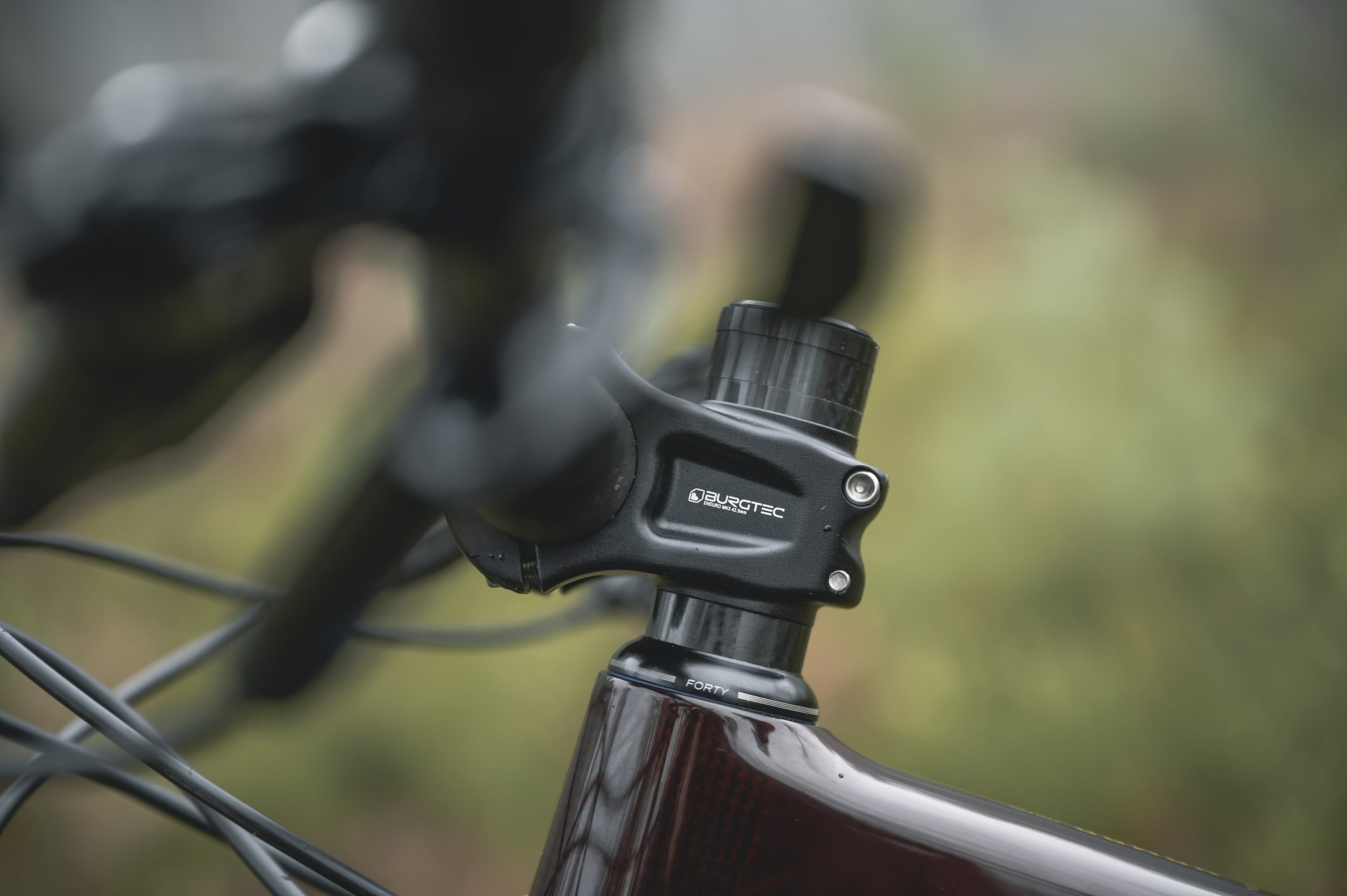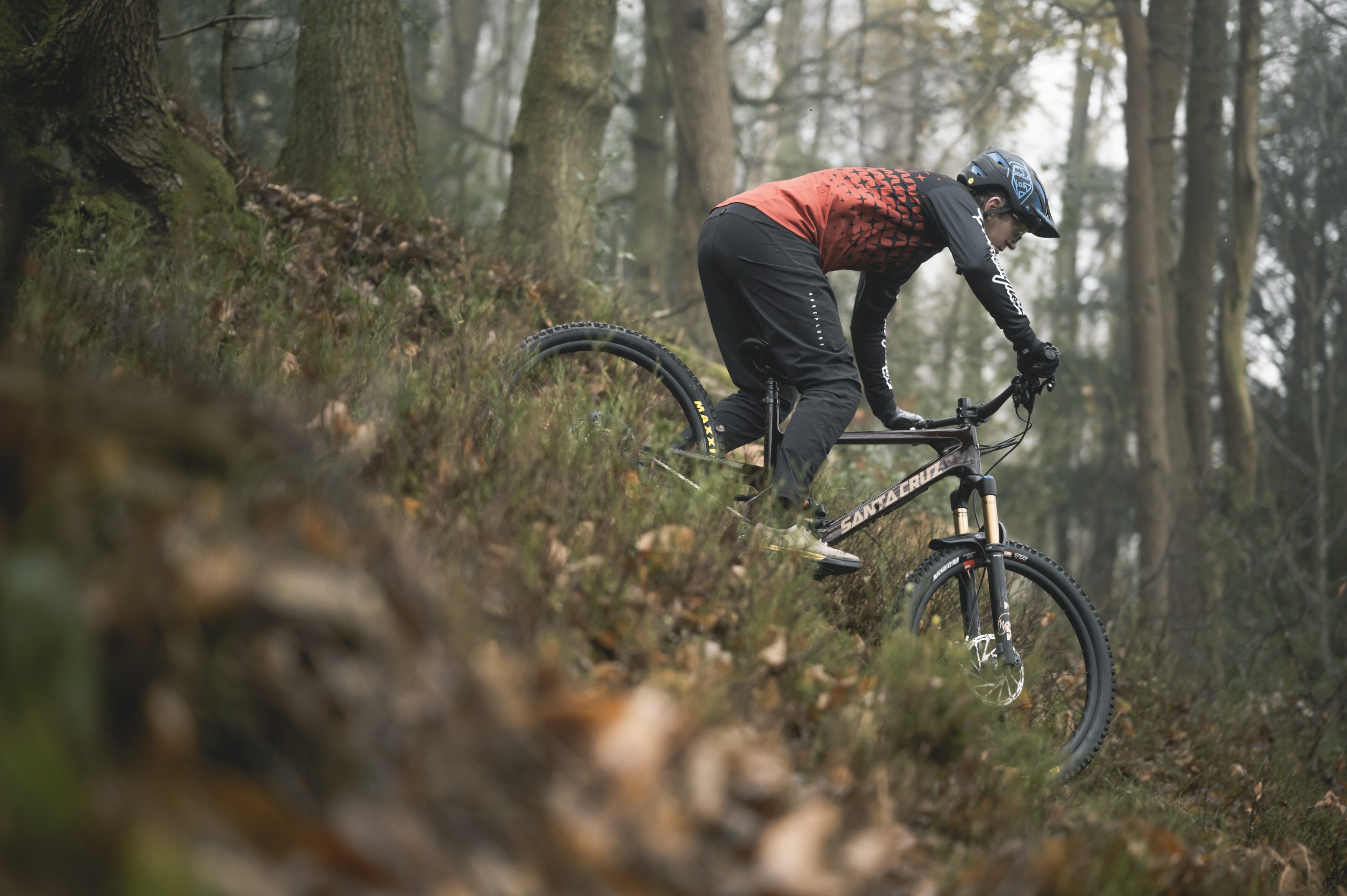Mild facelift for the iconic Santa Cruz Nomad. Subtle re-profiling of the head tube and BB area with crisp edges and sharp creases.
Santa Cruz Nomad CC X01 RSV (2021) first ride review
Santa Cruz gives its iconic Nomad a mild facelift, but has it gained a new lease of life? The Santa Cruz Nomad needs no introduction, so apologies for being really annoying and making one anyway. Launched in 2005 with a hunchback, hydroformed alloy frame, it originally came under the all-mountain banner – which, at the time, was probably best described as ‘Trail’ with a capital ‘T’, or ‘freeride’ with a small ‘f’.
Read more: Guide to the best enduro mountain bikes
Santa Cruz Nomad CC need to know
- Reach goes up on largest three sizes and seat tubes get shorter
- Proportional chainstays to keep weight balance constant across the size range
- Keeps the 27.5in wheels and 170mm travel of the old model
- Six model range starts at £4,499 for the Nomad C R
In 2010 the first carbon Nomad was introduced, followed in 2014 by the third iteration with much more modern geometry and – shock, horror – 27.5in wheels. By that point, the Nomad had become the desktop wallpaper bike for a generation in the same way that the Ferrari F40 was the poster car of the late eighties. It sold like hot cakes, and just about let you get away with being over-biked.
V4 victory
Finally, three years ago the Nomad 4 was released, and with it a wholesale change of chassis design and suspension kinematics that, after several small, incremental steps, represented a genuine leap in performance. That lower link driven shock, first used on the V10, got rid of the old VPP ‘hammock’ effect where the suspension would settle into the mid-stroke, and it brought more consistent performance, simpler set-up and better tunability.
But it upset the Santa Cruz faithful. The new frame configuration didn’t go down well, and looking through the comments of the video we released at its launch, a common theme is the use of the word ‘ugly’. Three years later and familiarity has bred acceptance. No longer does it look weird or quirky, and the performance gains from moving the shock were transformative. When we last tested the Santa Cruz Nomad CC in 2018 we absolutely loved it, rating it 9/10 and pronouncing it was the ‘best Santa Cruz suspension bike to date’.
Evolution not revolution
So to now, and the brand new Nomad v5. Guess what? When the recipe is as successful as that, you don’t mess with the ingredients. Against my best guess, Santa Cruz has not turned it into a mullet bike, it has merely gone in and adjusted the seasoning, which might not spark heated debate in the comments like the last one, but it makes perfect sense from a business perspective. That doesn’t mean that the new Nomad hasn’t evolved – the sizing has been stretched (which was one of our few complaints on the precious bike) along with a reskin using the latest design language unveiled earlier this year on the Santa Cruz 5010. That means crisp edges and striking creases, with a carved out web behind the head tube and an origami fold across the belly of the shock tunnel.
Proportional chainstays
Also carried over from the Santa Cruz 5010 and the Santa Cruz Hightower are proportional chainstays, where by changing the position of the lower link relative to the BB, the rear centre length can be altered without going to the expense of making different swingarms. The benefits are that front and rear wheels both grow further apart from the BB as you move up the size range, so your weight distribution remains relatively consistent on the bike no matter how tall you are. For the record, rear centre measurements range from 425mm to 440mm in 5mm increments, while the reach grows in 25mm steps from 425mm to 500mm. Before we move on, it’s also worth noting that the seat tubes are now significantly shorter on every frame size, with longer dropper posts filling the gap.
Coil-shock option
Just like the previous Nomad, the frame is coil shock friendly, both in terms of kinematics and clearance through the shock tunnel. In fact there’s a no-cost coil option on all but the two entry-level models. Santa Cruz has tweaked the leverage curve too, using a longer stroke shock to reduce the average leverage rate through the travel compared to the v4 Nomad, coupled with a little more progression for the last 15-20mm of travel.
Better cable routing and frame protection
The cable routing has been brought in line with the other bikes in the range and now runs cleanly whether you ride with your front brake on the left or the right. Reinforcements have been made to the integrated frame protection, with the underbelly rock and pick-up pads being supplemented by a further section beneath the chainstay yoke and the ribbed protector now enveloping the entire chainstay just behind the chainring.
Adjustable geometry
You still get a flip chip at the rear shock eyelet, giving 4mm of BB height adjustment and 0.3º of head and seat angle variation as well as increasing suspension progression slightly. We left it in the high setting for the test in an undisclosed South Wales valley, as we never felt the need to go lower or slacker for the long, steady climbs and steep, natural enduro tracks. Perhaps for bike park terrain, where pedalling is surplus to requirements, I’d consider the low position.

The Santa Cruz Nomad C R is the cheapest in the range at £4,499
Range overview and pricing
All bikes in the six-model range (starting at £4,499) get 38mm stanchion forks with 170mm of travel, a figure which is matched out back and we got pretty close to when we measured the actual travel (168mm on our test bike). There are three models with the heavier, and marginally cheaper carbon C frame starting with the Nomad C R fitted with a RockShox Zeb and SRAM NX Eagle drivetrain. Next in the range is the Nomad C S with Fox 38 Performance fork and SRAM GX Eagle drivetrain for £5,399, followed by the Nomad C XT with Fox 38 Performance Elite fork, Shimano XT drivetrain and coil-shock option for £6,099.

Nomad C XT with coil in Adder Green is £6,099
Moving up the CC frames, there’s the XT RSV with Fox 38 Performance Elite fork, Reserve carbon wheels and XT drivetrain for £7,099, a CC X01 model with Fox 38 Factory fork and X01 Eagle for £6,599 and this, the CC X01 RSV with Reserve carbon wheels for an extra £1,200. Although our bike came fitted with a RockShox Reverb, the UK spec lists the KS Lev dropper post in its place. Not the end of the world, but we find the Lev’s propensity for extending every time you pick the bike up by the saddle is mildly annoying.

Head tubes have got longer across the board, but we didn’t feel the need to slam the 40mm Burgtec Enduro stem
Other components of note are the chunky Burgtec stem (40mm on all sizes), Maxxis Assegai/Maxxis Minion DHR II tyre combo with sticky Maxx Grip compound up front and EXO+ casing (Double Down on coil-equipped bikes), superlative and ultra adjustable Fox Float X2 shock.
As always, going some way to mitigate the high price tag is the enviable rider support package, including a lifetime warranty for the frame and wheels and free lifetime bearing replacements.

Sizing has grown across the range, but the Nomad never feels unmanageable
How it rides
If you’ve read our review of the Nomad v4 from a couple of years ago, you’ll know how much we loved that bike. It was one of those guilt-free enduro bikes, that was completely at home blasting an alpine descent, but scarily efficient climbing back up for another run. If the Nomad had a party trick, it wasn’t how much roost you could generate drifting into a turn, or how easy it was to manual – although it could do both those things at will – it was how efficiently you could pedal to the top of the hill.

The new Nomad picks up where the old bike left off, but with a noticeably more spacious riding position. We measured our bike at 479mm reach, a touch more than the geometry chart claims, and around 20mm more than the old size large. Interestingly the head tube is much longer than on the old bike, some 20mm on the large, and while this felt out of place on the short travel 5010, it never jarred on the Nomad. Perhaps a result of the steeper terrain it’s likely to encounter. Either way, we were surprised that such a big change, affecting a major contact point, would go under the radar when riding.

If the previous Nomad defied logic on the climbs, the new one seems accomplished if not exactly mind-blowing. We have a hunch this is not the fault of the Nomad itself, but more that other enduro bikes have caught up in the balance between bump absorption and pedalling efficiency. And the fact that it comes with a sticky Maxx Grip compound Assegai up front that leeches itself to the ground, with every knob literally needing peeling off the dirt in search of forward progress. Yes, the extra grip is welcome for alpine trips, but here in the UK, the extra rolling resistance can be soul-destroying if you’re not supremely fit.
There’s more pedal mush and bob than I remember, too. Nothing that can’t be cured by a quick flick of the compression switch on the Fox Float X2 shock, but I don’t remember ever feeling the need to do that on the old bike in either coil or air guise.

Even with the growth in reach and stack, agility remains a Nomad highlight. Changes of direction are available on tap, and there’s acres of room to move around the bike and shift your weight balance, without getting tangled up in the back wheel. Was I slashing turns, popping out of turns and throwing shapes down every trail like it says I would in the press release? Not exactly, mostly because I was too focused on maintaining my hard won momentum in the face of that extra drag from the front tyre.
Square-edge bumps and roots can still trip up the suspension a touch, and my feet got shifted a couple of times on the pedals on rougher sections, but mostly the suspension feels utterly composed. The Float X2 shock gives masterly control in both directions, feeling supple on minor trail ripples but pillow-y deep on big hits and harsh landings. You can tune it in a myriad of ways too, more than I had the time to try, but initial sag set-up is actually easier than most Santa Cruz’s because the O-ring is not concealed by the shock tunnel.

If the old Nomad heralded the start of Santa Cruz’s phenomenally strong current line-up, so the new Nomad builds on that success in a subtle way. It has better sizing, more consistent handling for different height riders and perfectly polished detailing. There’s no doubt it’s a great bike, but the question I kept asking myself on the long climb up a steep Welsh hillside was, ‘who is going to buy this bike?’ My gut feeling is that the goalposts have moved at this travel and price point in the last couple of years. Riders have either got used to 29in wheels, or they’re moving on to e-bikes. If you only ride park, with access to a shuttle or chairlift, then happy days. But how many of us do that? My biggest concern with the Nomad then, is nothing to do with performance, but that it has ended up lost in the wilderness.






















